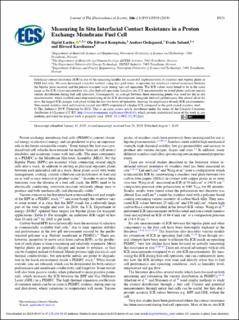| dc.contributor.author | Lædre, Sigrid | |
| dc.contributor.author | Kongstein, Ole Edvard | |
| dc.contributor.author | Ødegård, Anders | |
| dc.contributor.author | Seland, Frode | |
| dc.contributor.author | Karoliussen, Håvard | |
| dc.date.accessioned | 2020-12-23T12:07:55Z | |
| dc.date.available | 2020-12-23T12:07:55Z | |
| dc.date.created | 2019-09-08T01:35:21Z | |
| dc.date.issued | 2019 | |
| dc.identifier.citation | Journal of the Electrochemical Society. 2019, 166 (13), F853-F859. | en_US |
| dc.identifier.issn | 0013-4651 | |
| dc.identifier.uri | https://hdl.handle.net/11250/2720944 | |
| dc.description.abstract | Interfacial contact resistance (ICR) is one of the remaining hurdles for successful implementation of stainless steel bipolar plates in PEM fuel cells. We have developed a reliable method, using thin gold wires, to measure the interfacial contact resistance between the bipolar plate material and the porous transport layer during fuel cell operation. The ICR values were found to be in the same range as the ICR values measured ex situ after fuel cell operation. Local ex situ ICR measurements on tested plates indicate uneven current distribution during fuel cell operation. Consequently, an average between three measuring points was used for the in situ measurements, which enabled consistent monitoring of the ICR development alongside fuel cell performance. For almost all of the tests, the largest ICR changes took place within the first two hours of operation, showing the importance of early ICR measurements. Non-coated stainless steel and titanium-coated steel BPPs experienced a higher ICR compared to the gold coated stainless steel. | en_US |
| dc.language.iso | eng | en_US |
| dc.publisher | IOP Science | en_US |
| dc.rights | Navngivelse 4.0 Internasjonal | * |
| dc.rights.uri | http://creativecommons.org/licenses/by/4.0/deed.no | * |
| dc.title | Measuring In Situ Interfacial Contact Resistance in a Proton Exchange Membrane Fuel Cell | en_US |
| dc.type | Peer reviewed | en_US |
| dc.type | Journal article | en_US |
| dc.description.version | publishedVersion | en_US |
| dc.rights.holder | © The Author(s) 2019. This is an open access article distributed under the terms of the Creative Commons Attribution 4.0 License (CC BY, http://creativecommons.org/licenses/by/4.0/), which permits unrestricted reuse of the work in any medium, provided the original work is properly cited. | en_US |
| dc.source.pagenumber | F853-F859 | en_US |
| dc.source.volume | 166 | en_US |
| dc.source.journal | Journal of the Electrochemical Society | en_US |
| dc.source.issue | 13 | en_US |
| dc.identifier.doi | 10.1149/2.1511912jes | |
| dc.identifier.cristin | 1722549 | |
| cristin.unitcode | 7401,80,64,0 | |
| cristin.unitcode | 7401,80,62,0 | |
| cristin.unitname | Materialer og nanoteknologi | |
| cristin.unitname | Bærekraftig energiteknologi | |
| cristin.ispublished | true | |
| cristin.fulltext | original | |
| cristin.qualitycode | 2 | |

